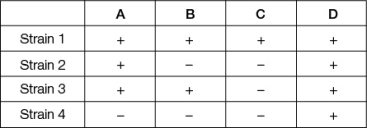Suppose that a certain wild-type bacteria can synthesize substance D, but various mutant strains cannot.We know that substance D is synthesized from substance X in a pathway that involves three intermediate substances (A, B, and C) , but we do not know the order of the steps in the pathway.The table shows four different mutant strains that have been tested for their ability to grow on the various substances.The "+" means that the strain can grow on that substance.The "‒" means that the strain cannot grow on that substance.  What is the most likely order of the pathway? (For example, A B C D indicates that substance A is converted to substance B, which is converted to substance C, which is converted to substance D.)
What is the most likely order of the pathway? (For example, A B C D indicates that substance A is converted to substance B, which is converted to substance C, which is converted to substance D.)
A) A B C D
B) A C B D
C) B A C D
D) C B A D
E) C A B D
Correct Answer:
Verified
Q12: The study of Neurospora mutants grown on
Q13: Mapping studies have showed that within a
Q14: The "central dogma of molecular biology" states
Q15: The study of Neurospora mutants grown on
Q16: One can argue that although the existence
Q18: Which molecule is used in transcription?
A) GTP
B)
Q19: Geneticists would expect alkaptonuria to be _
Q20: The phenotype of an organism is primarily
Q21: Humans share the same genetic code with
A)
Q22: Compared with DNA replication, transcription is _
Unlock this Answer For Free Now!
View this answer and more for free by performing one of the following actions

Scan the QR code to install the App and get 2 free unlocks

Unlock quizzes for free by uploading documents